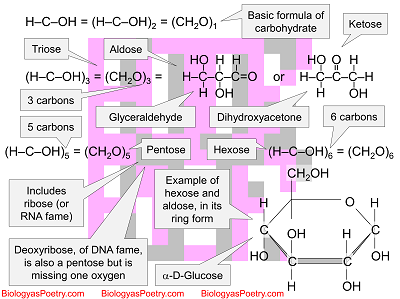∞ generated and posted on 2016.08.25 ∞
Most important hexose in biology and constituent of starches as well as cellulose.
Glucose, a monosaccharide, is the most common sugar in animal bodies. Glucose, particularly as dextrose or D-glucose as employed by biological systems, is the subunit from which amylose, amylopectin, and glycogen starches are polymerized and which serve as glucose storage molecules. Glucose is also the subunit from which cellulose, the most common polymer on Earth, is composed.
In addition to being a hexose, glucose also is an aldose.

Figure legend: Different ways of looking at the basic subunit of carbohydrates: monosaccharides. Note that (C2O)n basic formula (n carbons = C, n oxygens = O, and 2 × n hydrogens = H, where n is some number, such a 3, 4, 5, or 6). A hexose thus has six carbon atoms, six oxygen atoms, and 12 hydrogen atoms. Note also that monosaccharides are often drawn with not all carbons (C) explicitly shown (unlike as indicated here, particularly in the lower right).
Glucose is found in two basic types in biological systems, α-D-glucose and β-D-glucose, where are different anomeric forms (different in the location of a hydroxyl group, that is, -OH on one of their carbons). The α-D-glucose form is the constituent of starches whereas the β-D-glucose is the constituent of cellulose.
Glucose is a water soluble molecule that must be transported across lipid bilayers, as facilitated by proteins, to enter cells. It is the common starting point of the most ubiquitous of metabolic pathways, glycolysis. It is also known as blood sugar and is the preferred carbon source of many bacteria.